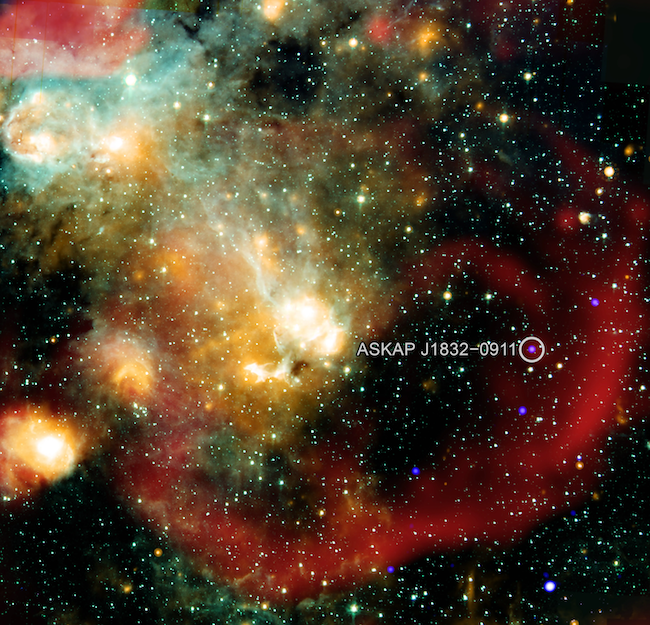Now Reading: Unusual star pulsing in X-ray and radio baffles scientists
-
01
Unusual star pulsing in X-ray and radio baffles scientists
Unusual star pulsing in X-ray and radio baffles scientists

This video features an interview with Curtin University’s Ziteng (Andy) Wang, the lead author of a paper on an unusual star that emits pulses in X-ray and radio wavelengths every 44 minutes. Video via the International Center for Radio Astronomy Research in Australia. Used with permission
- ASKAP J1832-0911 is the only known star to emit synchronized pulses of radio and X-ray waves every 44 minutes.
- Scientists classify this star as a long-period transient, a rare type of star first identified in 2022. But this is the first time such a star has been found emitting X-rays.
- Researchers are unsure what causes this behavior, suggesting it could involve a magnetar or a binary system with a white dwarf, or it may point to entirely new stellar physics.
Unusual star emits pulses in X-ray and radio wavelengths
Astronomers study stars in a wide range of wavelengths to gain a fuller view of their nature. They observe stars in short wavelengths, like gamma rays and X-rays, to visible light to long wavelengths like radio waves. On May 28, 2025, scientists in Australia said they’ve found a one-of-a-kind star. It’s called ASKAP J1832-0911, and it emits a two-minute-long radio pulse every 44 minutes. But what makes it unusual is that a space-based X-ray observatory also detected X-ray pulses at the same time.
The paper’s lead author, Ziteng (Andy) Wang of Curtin University, said:
Discovering that ASKAP J1832-0911 was emitting X-rays felt like finding a needle in a haystack.
This object is unlike anything we have seen before.
Wang and his colleagues published their peer-reviewed findings in the journal Nature on May 28, 2025.

ASKAP J1832-0911 is a long-period transient star
Long-period transient stars are stars that emit pulses of radio waves every few minutes to hours. (They are different from pulsars, highly magnetized compact stars, that spin extremely rapidly — over milliseconds to seconds — and emit pulses in a wide range of wavelengths.)
Astronomers first discovered these unusual stars in 2022. Since then, they have only found 10 long-period transients. Astronomers found these strange objects using modern radio telescopes that can observe wide fields of the sky.
And astronomers have classified ASKAP J1832-0911, about 15,000 light-years away in our Milky Way galaxy, as a long-period transient. That’s because it emits radio waves every 44 minutes, for about two minutes in duration. Australian astronomers – using the ASKAP radio telescopes – discovered it in late 2023. So the star gets its name from the observatory where it was first detected.
Wang also wrote about ASKAP J1832-0911 in The Conversation. And he said that after its discovery, scientists conducted follow-up observations to better characterize it, including determining its two-minute radio emission ever 44 minutes. In addition, they looked for evidence of this star in old radio data but came up empty. Wang said in The Conversation:
This suggests something dramatic happened shortly before we first detected it – something powerful enough to suddenly switch the object ‘on.’
And in February 2024, the star became even brighter in radio wavelengths. Wang wrote that ASKAP J1832-0911 was 10,000 times brighter than most stars detected in the radio sky.
First discovery of a long-period transient emitting X-rays
Coincidentally, in February 2024, the Chandra Space Telescope was looking near the same region of the sky as ASKAP J1832-0911 in X-ray wavelengths.
Wang was able to obtain that X-ray data from a colleague at Columbia University. To his amazement, he saw clear X-ray signals from ASKAP J1832-0911, following the same 44-minute cycle seen in the radio data.
He remarked:
The ASKAP radio telescope has a wide field view of the night sky, while Chandra observes only a fraction of it. So, it was fortunate that Chandra observed the same area of the night sky at the same time.

Why the unusual star ASKAP J1832-0911 is so intriguing
Scientists do not understand what’s going on at ASKAP J1832-0911. Short wavelengths like X-rays are usually emitted by highly energetic events, but radio waves are associated with weaker phenomena.
Wang commented:
ASKAP J1831-0911 could be a magnetar [the core of a dead star with powerful magnetic fields], or it could be a pair of stars in a binary system where one of the two is a highly magnetized white dwarf [a low-mass star at the end of its evolution].
However, even those theories do not fully explain what we are observing. This discovery could indicate a new type of physics or new models of stellar evolution.
Co-author Nanda Rea of the Institute of Space Sciences in Barcelona, Spain, added:
Finding one such object hints at the existence of many more. The discovery of its transient X-ray emission opens fresh insights into their mysterious nature.
What was also truly remarkable is that this study showcases an incredible teamwork effort, with contributions from researchers across the globe with different and complementary expertise.
ASKAP J1831-0911 remains a mystery. Astronomers need to obtain more data in both radio and X-ray wavelengths of this enigmatic object. Also, they need to observe more long-period transients in X-ray. After all, they could be looking at an entirely new type of celestial object.
Bottom line: Astronomers have discovered a new type of star. It emits both radio and X-ray wavelength pulses every 44 minutes.
Source: Detection of X-ray emission from a bright long-period radio transient
Via:
International Center for Radio Astronomy Research (ICRAR)
The post Unusual star pulsing in X-ray and radio baffles scientists first appeared on EarthSky.
Stay Informed With the Latest & Most Important News
Previous Post
Next Post
-
 012024 in Review: Highlights from NASA in Silicon Valley
012024 in Review: Highlights from NASA in Silicon Valley -
 02Panasonic Leica Summilux DG 15mm f/1.7 ASPH review
02Panasonic Leica Summilux DG 15mm f/1.7 ASPH review -
 03From Polymerization-Enabled Folding and Assembly to Chemical Evolution: Key Processes for Emergence of Functional Polymers in the Origin of Life
03From Polymerization-Enabled Folding and Assembly to Chemical Evolution: Key Processes for Emergence of Functional Polymers in the Origin of Life -
 04How New NASA, India Earth Satellite NISAR Will See Earth
04How New NASA, India Earth Satellite NISAR Will See Earth -
 05And Thus Begins A New Year For Life On Earth
05And Thus Begins A New Year For Life On Earth -
 06Astronomy Activation Ambassadors: A New Era
06Astronomy Activation Ambassadors: A New Era -
07SpaceX launch surge helps set new global launch record in 2024




















